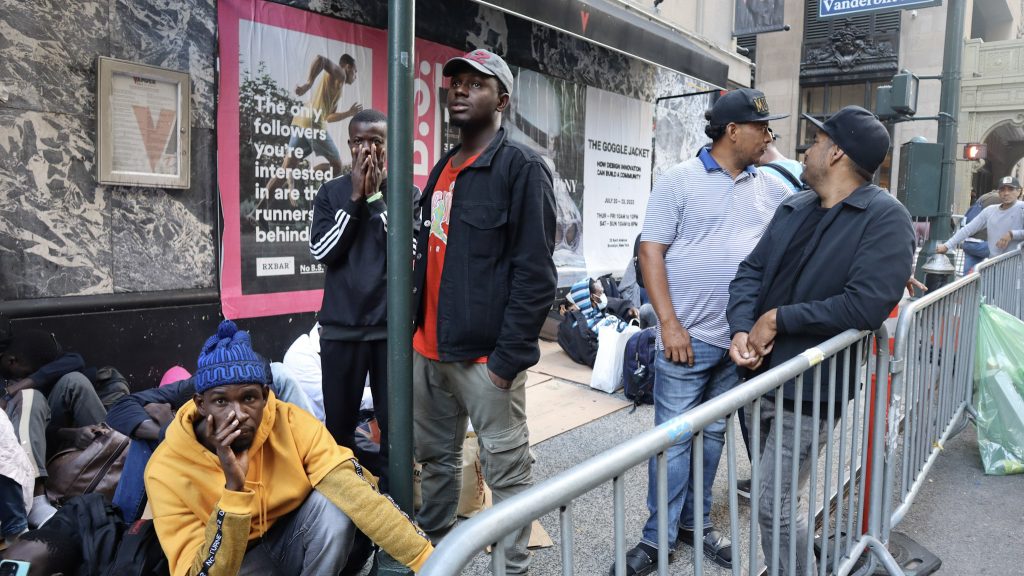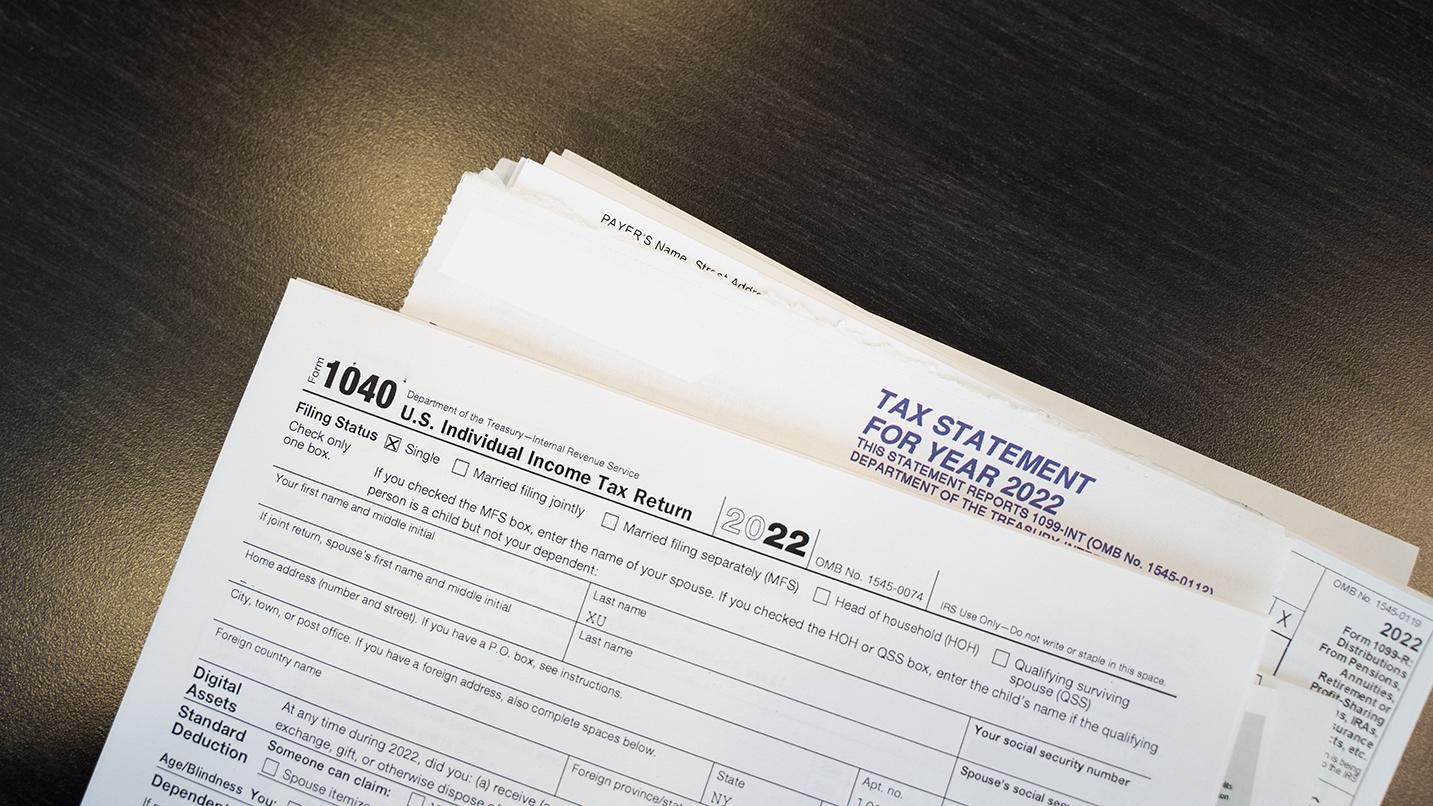The group lay on ripped cardboard boxes besides grocery bags that contained their limited belongings on the sidewalk outside the Roosevelt Hotel in Midtown. One man poured a water bottle over his head and neck, and used his fingers to brush his teeth. Some asylum seekers said they hadn’t been able to shower in five days. They had been using the bathroom at Grand Central Station because they said they were not allowed into the hotel.
Also Read: Migrants Sleep On The Streets of NYC
On Thursday, the City cleared the sidewalk outside the Roosevelt. Only some metal barriers and orange cones remained as a worker cleaned the concrete with a hose on Thursday afternoon. For days previous, many asylum seekers were told the City had no shelter to give them, so they had spent days sleeping on the sidewalk.
They had all traveled thousands of miles: From Peru, Senegal, Venezuela, Mauritania and other countries, with a vision of New York that at the very least included a bed to sleep in, and a roof over their heads. But they soon found that this could not be guaranteed – for the time being, the asylum seekers would have to stay overnight on the street. Several said they had no alternatives.
For more than a year, the City has been contending with the formidable task of finding housing for the tens of thousands of asylum seekers who have steadily arrived in New York for almost a year and a half. Unused schools, half finished buildings, and former prisons have all been converted into temporary shelters, and the asylum seekers continue to arrive on a daily basis. But, despite this effort, the majority of asylum seekers who have stayed in city care have not left the shelter system, and an average of about 500 asylum seekers are still coming to the city per day, according to city officials. Asylum seekers Documented spoke with say they want to leave the shelters, but delays in obtaining work authorization, ineligibility for rental assistance, and high rents across the city created significant barriers for many to find permanent housing.
Out of the roughly 95,600 asylum seekers who have gone through the City’s intake system since last spring, 56,200 people are still in the City’s care, Deputy Mayor for Health and Human Services Anne Williams-Isom said at a press conference this week. In March 2022, more than 40,000 people were in the shelter system, according to Department of Homeless Services data. As of July 30, there are almost 108,000 people in city care, Williams-Isom said. Mayor Eric Adams declared this week that “there is no more room” in the system. So hundreds have slept on the street in recent days while they wait for shelter intake, while families already living in shelter spaces say they don’t know when moving into a home on their own will be within reach.
“I would like to move out of the shelter so I’m not relying on the government,” said Yeraldin Ruiz, a 24-year-old asylum seeker from Venezuela who has been staying at a Queens hotel shelter with her husband and three-year-old daughter for a year. “I know there are other people that also need that opportunity and I would like to give it to them.”
Ruiz and her family came to New York City from Venezuela over a year ago now. She still hasn’t been able to find work and doesn’t have a social security number. She said that only her husband is working, while she takes care of their daughter, and his income wouldn’t be enough to cover rent. Her family has applied for rental assistance vouchers, but was told they were ineligible.
Ruiz said that shelter staff has asked her several times when she was planning on moving out of the facility. “I said, how do you expect me to move if nobody will rent to me? I told them I don’t want to stay here. I want to move,” she said outside the Row Hotel in Manhattan, now used as a shelter for asylum seekers.
Last week, Mayor Eric Adams met with Alejandro Mayorkas, the Secretary of the Department of Homeland Security. The members of the Adams administration emphasized the City’s need for access to federal properties to house asylum seekers, a sped-up work authorization process, a federal emergency declaration to unlock more federal funds, and a national decompression strategy that would house asylum seekers in cities other than New York, Williams-Isom said. “We made it clear that New York City cannot continue to carry the weight of a national problem on our own,” she said.
The City is now limiting shelter stays for individual adult asylum seekers to 60 days. The rule applies to single men only, Williams-Isom said on Wednesday. Since the regulation was enacted, the City has handed out about 800 notices to those who have been staying in the system for more than 60 days, she said.

Last week, more than 2,300 new asylum seekers were taken into city facilities, Williams-Isom said. “If less people were coming through the front door, maybe we could catch up a little bit with getting exit strategies going,” she said.
But advocates have urged the City to focus on aiding asylum seekers with finding affordable housing, so they can move to permanent housing. “The families are going to have a real struggle in getting out of the shelter, because there are no programs to support them,” Murad Awawdeh, the executive director of the New York Immigration Coalition, said in an interview with Documented.
Awawdeh said that until they can move forward with their immigration case and gain some sort of immigration status, families are largely unable to access various forms of housing assistance, like CityFHEPS, a rental assistance supplement administered by the Department of Social Services. “So they’re going to be in there for quite some time,” he said about families in shelters.
Josh Goldfein, a lawyer with the Legal Aid Society said that the system “presumes that people are eligible for housing assistance and tries to connect them to those programs.”
But, he said, “the arriving asylum seekers are mostly not eligible for that kind of assistance.”
A spokesperson for City Hall said that Mayor does not have the authority to decide who is eligible for rental assistance. The City cannot make CityFHEPS available to asylum seeker households — including families and individuals — without changes to state law, which would require state-level legislation, according to the spokesperson. In order to expand the program to include noncitizens the City would need to receive additional resources from state and federal partners, the spokesperson said.
Alexandra Moina, 39, has been staying at a Gowanus hotel shelter with her partner and her 13-year-old daughter for six months. Moina, who is from Ecuador, does not have any friends or family in the city that she can stay with. She was only able to find work for one month cleaning apartments, she said, but had to leave because her employers stopped paying her. Moina hasn’t been able to obtain official work authorization yet. “That’s why they took advantage of me,” she said in Spanish.
She has been going to a soup kitchen in Brooklyn called CHiPS every day to pick up the kinds of foods she said aren’t available at her shelter nearby. But she doesn’t want to rely on the city’s shelter system much longer, she said while she stood in line at the soup kitchen for breakfast. Still, without a stable job, rents are too expensive to move out. Her family is going through immigration proceedings, but “it takes a long time,” Moina said. “Step by step, it’s a process.”
Pauline Auguste, the director of food services at CHiPS, said that since January, the soup kitchen is serving double the amount of people it had previously served–up from about 200 a day, to roughly 400 people a day. Many of them are asylum seekers who have been staying in shelters for months at a time. “We do have the same families that are coming every day, on a daily basis,” Auguste said.
Advocates have expressed frustration with the Adams administration communication around their efforts to serve asylum seekers. In an interview with Documented, Shahana Hanif, the chair of the New York City Council Immigration Committee, said the City has not adequately coordinated its plans to shelter asylum seekers with elected officials.
“We want to be able to build the infrastructure to support these individuals, their families, and their children, for the long haul,” Hanif said.
The spokesperson for City Hall said that the Adams administration continuously briefs elected officials on the situation with asylum seekers, notifies elected leaders every week on the latest available information, and has engaged in various city council hearings.
At the Roosevelt Hotel, meanwhile, asylum seekers were sleeping on the sidewalk since last week, before the area was cleared on Thursday. The Legal Aid Society and the Coalition for the Homeless threatened to sue the Adams administration over the situation if the City did not find housing for them. Manhattan Borough President Mark D. Levine called it the “epicenter of a national refugee crisis.” Williams-Isom said in her briefing this week that the situation was “heartbreaking.” Mayor Adams maintained: “It’s not going to get any better.”
Documented interviewed more than a dozen asylum seekers outside the Roosevelt Hotel over the past two weeks. Some said that while the conditions were not ideal, they had little choice but to wait on the stretch of the sidewalk assigned to them.
Leonardo Antonio Ramirez Peña, 30, had been sleeping for two days outside the Roosevelt on Tuesday, after a three months-long journey from Venezuela, he just hoped to find a place to rest so he could start to work, he said. “We don’t care what kind of shelter we get,” he said.
Monica Martinez, 46, chose to come to New York because she heard that there was shelter. But when she arrived at the Roosevelt hotel at the start of the week, she realized that her bed that night would be on the concrete. Martinez, who is from Peru, was one of very few women in the line – and seemingly the only one who was on her own, she said. Everyone in the line had been kind, but she was still concerned for her safety as a woman, unaccompanied, on the street at night, she said. “I didn’t sleep at all,” she said.
For some in the line, it wasn’t their first time going through the shelter intake process. Savi Khalil, an asylum seeker from Mauritania, had come to New York three months ago and lived in the shelter system for about two months. But after finding no employment without a social security number or a work permit, and living with two men he did not know in a hotel room in Queens, he left for a painting job in Ohio. He liked New York better though, he said, and came back. But the line at the Roosevelt was a surprise, he said on Tuesday. Last time he was immediately given a bed to sleep in. Still, Khalil, 31, was grateful for the kindness of New Yorkers, who gave him food and water in the line. He didn’t have any friends or family who could take him in, so he would wait as long as it takes. “I don’t have another choice,” he said.














